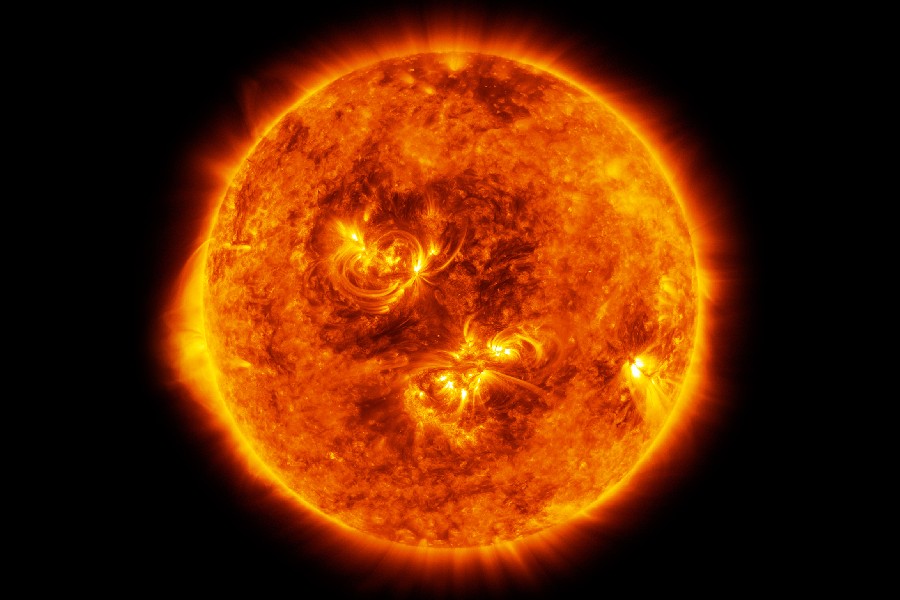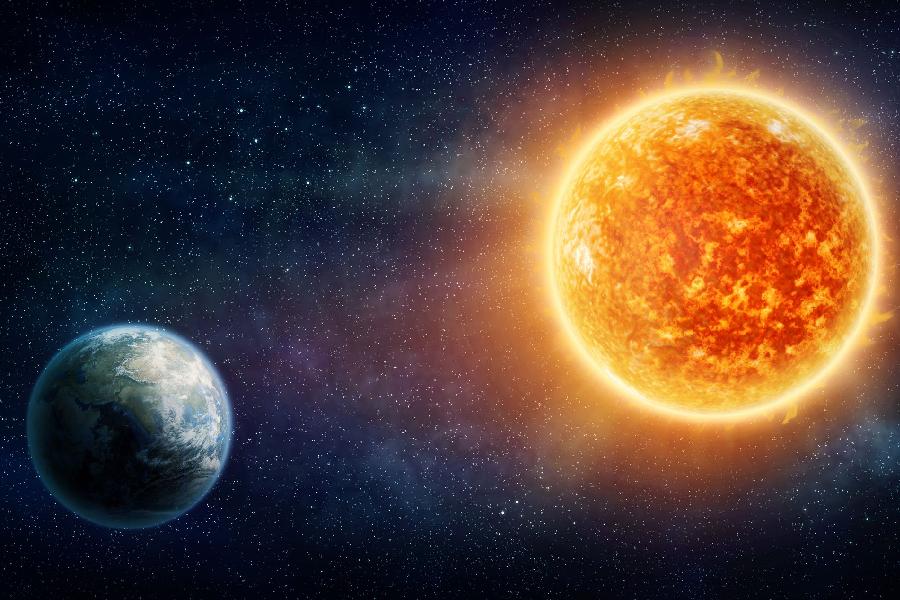The gigantic, blazing hot star sits at the center of our solar system and makes life on Earth possible. It may look like any ordinary star from our vantage point 93 million miles away, but the Sun is anything but ordinary. What Is the Sun exactly?
This ball of superheated plasma is a churning cauldron of intense energy, solar storms, and potent magnetic fields. Learning exactly what the Sun is and what its role is is key to understanding Earth’s climate, space weather, and even the potential for life elsewhere in the cosmos.
In this article, we’ll explore what the Sun is composed of, how it generates power, and why its atmosphere and magnetic field create solar activity. What would happen if the Sun simply vanished? Where did it come from in the first place?
Read on to discover why is the sun important and how it impacts our solar system at large. Getting to know the Sun may reveal answers about Earth’s past, present, and future like nothing else can.

What Is the Sun?
What is the Sun and why is the Sun important to the solar system? The Sun is a star and the center of our solar system. As a medium-sized yellow star, the Sun generates energy through nuclear fusion of hydrogen into helium deep in its core.
The Sun is about 4.5 billion years old – midway through its lifespan as a stable star. Through a delicate dance of nuclear fusion, it radiates a constant stream of photons, shaping the dynamics of planets, moons, and asteroids alike.
In the cosmic orchestra, the Sun assumes a pivotal role as the unrivaled source of energy and light, intricately weaving the tapestry of our solar system. This provides the light and heat that makes life possible on Earth and the other planets.
The Sun’s Life – From Birth to Maturity
The story of our trusty Sun began roughly 4.6 billion years ago. It started when a region within a large molecular cloud of hydrogen gas and cosmic dust began to coalesce under its own gravity.
Over tens of thousands of years, this interstellar matter condensed and flattened into a swirling, turbulent protoplanetary disk with material falling onto it.
As gravitational contraction continued, conservation of angular momentum caused the rotation rate to accelerate dramatically, forming a dense rotating spheroid in the heart of the developing system and thus forming a star. But, what type of star is the Sun?
When the temperature and pressure at the core climbed over 10 million K to ignite nuclear fusion, the Sun was officially born as a T Tauri star. This volatile adolescent phase lasted around 100 million years, with powerful stellar winds clearing the surrounding material to halt further growth.
The young Sun eventually stabilized onto the main sequence, fusing hydrogen atoms efficiently via the proton-proton chain reaction.
Currently middle-aged at 4.6 billion years, our steady Sun has been providing consistent luminosity for all planetary companions. Classified as a G-type main-sequence star or G2V, it sits in a period of approximate balance, generating energy through the fusion of hydrogen into helium atoms in the core region.
This enduring stability as what’s known as a dwarf star allows life on nearby planets to flourish. Our loyal companion will continue fusing hydrogen for approximately another 5 billion years before evolving into its final red giant phase.
The Sun’s Magnetic Influence
Our bright star Sun, generates an extensive magnetic field deep inside, stretching and twisting through the solar interior and atmosphere. Like an invisible web of energy, these magnetic lines well up from the solar surface, creating areas of density called magnetic flux tubes.
Due to gas currents, these tubes can become twisted and tangled, building up substantial amounts of magnetism. When the magnetic pressure overrides the hot gas pressure within the Sun’s outer layer, we get dark sunspots peppering the solar surface, along with bright solar flares dancing above.
It’s almost like a magnetic wrestling match at times! Above these localized active regions, charged particles stream outwards, carried along the magnetic field lines. This is the solar wind that fills the entire solar system, stretching the stellar magnetic field into space.
Higher in the atmosphere, magnetic flux tubes buoyantly rise up through the solar surface into the array of loops and arcs known as prominences. Billowing with hot plasma, these immense magnetic loops occasionally erupt, triggering glowing solar storms and energetic particle events.
So the Sun’s inner magnetism drives all the action on our dynamic star – from sunspots and looping prominences to dramatic flares shooting particles across the solar system. Our steady Sun sure keeps things interesting, thanks to its magnetic energy!

The Sun’s Dynamic Nature – A Solar Rhythm Unveiled
Understanding solar cycles
Delving into the dynamic nature of our radiant Sun unveils a rhythmic dance, a cosmic ballet orchestrated by cyclical patterns of solar activity. At the heart of this solar rhythm lie the solar minimum and solar maximum phases, where our bright star undergoes intriguing transformations.
- Solar minimum – During the solar minimum, the Sun takes a breather, exhibiting a temporary lull in activity. Sunspots become scarce, and the solar atmosphere experiences a subtle calm. It’s akin to a quiet interlude in the solar performance, a moment of cosmic serenity.
- Solar maximum – Contrastingly, the solar maximum marks a crescendo in the solar symphony. Sunspots proliferate, and solar flares illuminate the celestial stage. This heightened activity not only captivates astronomers but also holds implications for space weather, shaping the cosmic environment around our home planet.
Implications for space weather
These solar cycles bear significance beyond their celestial charm. Solar maximums bring intensified solar winds, magnetic storms, and heightened solar radiation, impacting space weather. Understanding these solar dynamics becomes paramount for safeguarding our technological infrastructure orbiting in the cosmic theater.
In this cosmic rhythm, the Sun’s dynamic interplay with space weather unfolds, reminding us of the intricate celestial choreography that influences our cosmic neighborhood.
Our Sun may appear tranquil from afar, but it beams out a continual flow of charged particles known as the solar wind. Let’s explore how these cosmic breezes interact with planets, moons, and more to shape the very nature of our solar system!
Solar Winds and Their Cosmic Reach
At a scorching 1.8 million degrees Fahrenheit, the outer layer of the Sun generates a flood of electrons, protons, and ionized atoms blowing off the surface. As extensions of the Sun’s expansive magnetic field, these charged solar winds wash outward at speeds up to 560 miles a second. Our intrepid solar spacecraft bravely took the brunt!
The closer a planet is to the Sun, the more intensely these breezes buffet its surroundings. Stubborn little Mercury with no atmosphere bears the full brunt, slowly shrinking over eons through the constant sputtering erosion.
Cloaked by a protective magnetic bubble, Earth luckily deflects most particles, though solar storms can rattle satellites. Far past frigid Pluto, these tenuous winds merge with galactic particle currents in a turbulent transition called the heliopause boundary.
Here, the meager leftovers finally submit to interstellar influences much further out. Though diminished by distance, the solar winds’ long reach extends over 10 billion miles, a testament to their ongoing cosmic journey.
So with charged grace, the solar winds ride the Sun’s expansive fields to cosmic domains far beyond the familiar worlds of our solar neighborhood. And we have front-row seats to it all!
The Sun-Earth Connection
Our steady Sun keeps planet Earth nourished, but its playful behavior can sometimes cause disruptions for technology and astronauts. Understanding the Sun-Earth connection helps protect infrastructure both on and off our planet from the whims of space weather.
As the Sun’s tangled magnetic field unleashes storms of charged particles towards Earth, they can overload power grids, corrode oil pipelines, and short out satellites.
The largest events trigger widespread radio blackouts and radiation risks for unshielded astronauts. In today’s tech-dependent world, solar flares pose increasing threats.
By monitoring the Sun’s active regions, space weather forecasts now give power companies days to prepare vulnerable equipment. Operators can even minimize grid loads when solar ion storms are en route. And satellite engineers can place instruments in safe mode before bombardments of energetic particles commence.
When we witness the beautiful northern lights, it’s a sign of solar outbursts. However, these outbursts can also expose Earth’s vulnerability to unpredictable stellar mood swings, affecting our electricity and communication networks. As human presence expands throughout the solar system, comprehending our life-giving star becomes crucial.
For over 4 billion years, the Sun has shone as a stellar anchor for life on Earth. As we venture farther out into space and build technological citadels both on and beyond our planet, we must track the sun’s fits of anger to safeguard our new toys!
Solar Observations
Ground-based solar tracking
A brilliant ball of hot plasma over 90 million miles away, our Sun poses quite the challenge for eager astronomers! A diverse toolkit of clever instruments studies solar mysteries from right here on Earth and even closer by venturing into space itself. Let’s shine some light on how science scrutinizes our stellar neighborhood.
Squinting through protective filters, ground-based solar telescopes utilize precision tracking and innovative designs to mitigate atmospheric distortion. Capturing crisp images of tumultuous sunspots and fiery flares helps identify eruptive regions threatening spacecraft and astronaut safety. Meanwhile, specialized detectors monitor the full solar spectrum, unraveling composition and probing interior physics from afar using proxies.
To the Sun and back – Spacecraft reveal our star up close
But to truly tackle the Sun’s dynamic behavior and driving processes, satellites venture where balloons don’t dare. Equipped with cutting-edge imagers and particle sensors plus sturdy sun shields, an armada of solar spacecraft like SOHO, SDO, and Parker Solar Probe bravely study our star up close.
These missions piece together the solar puzzle – twisting internal magnetism, supersonic wind acceleration, and hints of the hidden solar core. All while dodging violent outbursts!
Combining the strengths of ground and space observation, today’s solar astronomy toolkit leverages worldwide assets to probe the physics powering our life-giving Sun, without getting burnt in the process! Both up close and far away, human ingenuity perseveres.
Conclusion
As we conclude our tour of our magnificent Sun, we hope you have a greater appreciation for the fiery heart of our solar system. This article has illuminated some of the mysteries surrounding our nearest star – the processes occurring within, the dynamics shaping its surface, and the far-reaching effects of solar activity across a hundred planets and moons.
We explored the convection currents churning deep inside, tangled magnetic fields unleashing massive storms, and supersonic winds careening through interplanetary space. And we’ve only scratched the surface in answering: what is the Sun?
Underneath the glowing veneer of the Sun’s photosphere lies a complex cosmical furnace of plasma and magnetism. By combining observations across the electromagnetic spectrum from a diverse collection of ground and space instruments, astronomers are steadily compiling a more complete understanding of the forces driving solar behavior.
But with many enigmas yet to unravel, solar science remains a rich and vibrant area of research today. As new spacecraft venture closer than ever before to probe below the Sun’s surface, an era of unprecedented solar insights is sure to dawn. Our steady companion star still has plenty of surprises in store!
